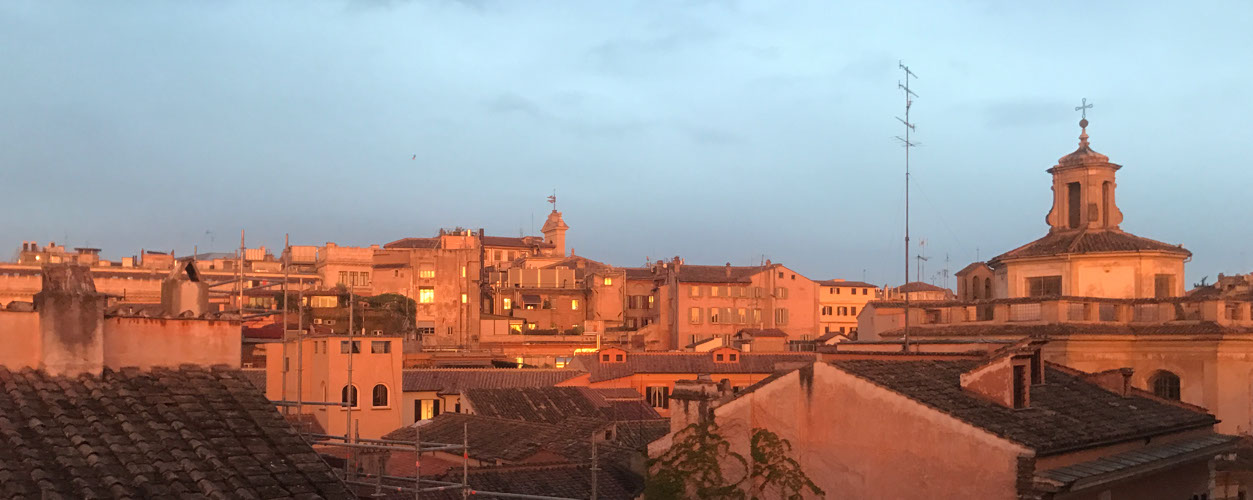A collection of things that you might find interesting as you walk about Rome.
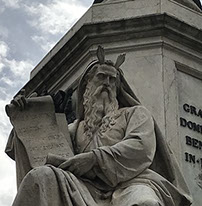 "Moses with Horns"
"Moses with Horns"
If you find yourself in ... The Piazza del Traforo, one hundred or so metres to the right as you look at the Spanish Steps, look at the monumental statues and obelisk in the centre of the piazza. See Moses, holding the tablet of the 10 Commandments... he has "horns" projecting from his head. This is the result of an early mis-translation of a phrase in the old testament, where Moses was actually said to have "rays of light" coming from his head, not horns.
There are other examples later in this list.
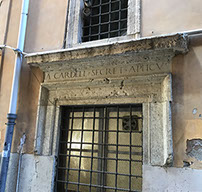 Carravaggio's studio.
Carravaggio's studio.
If you are in The via del Prefetti, which runs from Piazza del Parliamento towards the river, just before the Piazza Firenze you see on the right the Vicolo Divine Amore.
Just inside this small, dirty lane, is the original entrance to Caravaggio's studio. A little further along, turn right into the via Metastasio, then almost immediately on the right is the via Palacordia. This is the site of the tennis court (palacordia) where Caravaggio murdered his opponent before fleeing from Rome.
 The Campo dei Fiori is interesting for all sorts of reasons (it is also our base when in Rome), but for Australians, or more specifically those from Sydney, there is a little known connection.
The Campo dei Fiori is interesting for all sorts of reasons (it is also our base when in Rome), but for Australians, or more specifically those from Sydney, there is a little known connection.
In the centre is the statue of Giordano Bruno, burned at the stake here in 1600 for heresy. He was a "free thinker" who defied the church in his teachings.
In Sydney in the 1920's, a group of modern "free thinkers" had the opportunity of starting a radio station and named it after their hero Giordano Bruno... 2GB.
While in the Campo dei Fiori, wander over to the left hand corner, where the via Gallo leads off to the Piazza Farnese.
 There are two buildings that are now signed as Forno's (bakeries). The left-hand, smaller shop is the site of the "Taverna della Vacca" (The Cow's Tavern). The tavern was operated in the 1520's by Vannozza Caetani, the mistress of Pope Alexander VI and mother of the infamous poisoner, Lucrezia Borgia. You can still see her coat of arms on the building facade above the forno, which brazenly depicts together both her family's crest and that of the pope.
There are two buildings that are now signed as Forno's (bakeries). The left-hand, smaller shop is the site of the "Taverna della Vacca" (The Cow's Tavern). The tavern was operated in the 1520's by Vannozza Caetani, the mistress of Pope Alexander VI and mother of the infamous poisoner, Lucrezia Borgia. You can still see her coat of arms on the building facade above the forno, which brazenly depicts together both her family's crest and that of the pope.
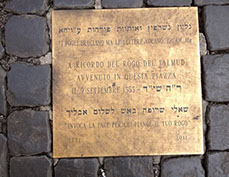 Also in the Campo dei Fiori ... In 1553, the Roman Inquisitors confiscated every copy of the Talmud in Italy. (The Talmud is a central text of Judaism. The Talmud contains the opinions of thousands of rabbis on a variety of subjects, including law, ethics, philosophy, customs, history, theology, lore and many other topics.)
Also in the Campo dei Fiori ... In 1553, the Roman Inquisitors confiscated every copy of the Talmud in Italy. (The Talmud is a central text of Judaism. The Talmud contains the opinions of thousands of rabbis on a variety of subjects, including law, ethics, philosophy, customs, history, theology, lore and many other topics.)
It took them 9 days to gather up all the copies. The search culminated on Rosh Hashana in 1553. On September 9, the Talmud and many other Jewish books were burned in Campo dei Fiori. This plaque, which was laid in 2011, commemorates the event. It can be found set into the pavement just to the left behind the statue of Bruno.
 Mussolini's Balcony in Piazza Venezia.
Mussolini's Balcony in Piazza Venezia.
As the traffic races round the Piazza Venezia, and brave pedestrians gather courage to cross it, it is perhaps hard to imagine that this was the most sacred of all the places that fascism sought to turn into symbols of its power. Mussolini delivered all his most important speeches, including the declaration of the Italian empire in May 1936, from this balcony that looks directly along the Via Fori Imperiali.
The balustrade has been cleaned up along with the rest of the facade of the imposing Palazzo Venezia, a Renaissance palace built in the 15th century by Pope Paul II.
Mussolini declared war on Britain and France from the balcony on June 10, 1940, to the cheers of thousands of Italians gathered in the piazza below.
 Nearby ... At the intersection of The Corso and the Piazza Venezia, there is a black enclosed balcony.
Nearby ... At the intersection of The Corso and the Piazza Venezia, there is a black enclosed balcony.
This apartment was the final home of the mother of Napoleon I, Maria Letizia Ramorino Bonaparte. The lady, who was exiled from France (after the fall of her son, the Emperor), lived here until her death in 1836. There is a projecting balcony on the first floor, where Madame Bonaparte would sit in privacy and watch the world go by in the busy piazza.
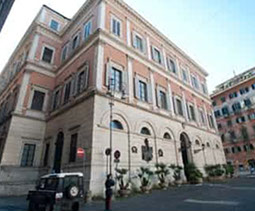 Belesconi's Rome residence.
Belesconi's Rome residence.
Palazzo Grazioli, in Via della Gatta. Though not the site of his most notorious 'bunga bunga' parties, he still hosted many a lavish party here.
 On the obelisk on the "Fountain of the Four Rivers" in the Piazza Navona.
On the obelisk on the "Fountain of the Four Rivers" in the Piazza Navona.
You can see the dove, symbol of the Pamphilj Pope, but what you can't see is that supposedly "The Pope is Great" has been added, in hieroglyphs, at the very top.
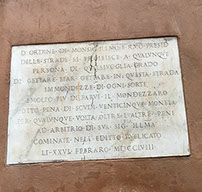 When walking through ...
When walking through ...
The Via Campo Marzio,
on the corner of the Vicolo della Torretta, on the wall is a marble plaque. This is a 1758 notice to the local community not to dump their rubbish here.
There are many more scattered all over old Rome, mostly on smaller side-streets.
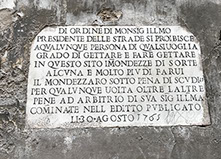 Another of the "No Dumping Rubbish" notices, this one from 1765, to be found on the corner of the Via Torre Argentina and the Via Monterone.
Another of the "No Dumping Rubbish" notices, this one from 1765, to be found on the corner of the Via Torre Argentina and the Via Monterone.
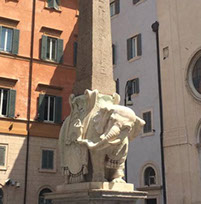 The Piazza della Minerva, about one hundred or so metres behind the Pantheon, is interesting for a couple of reasons, not just the magnificent Basilica Sopra Minerva.
The Piazza della Minerva, about one hundred or so metres behind the Pantheon, is interesting for a couple of reasons, not just the magnificent Basilica Sopra Minerva.
First, Bernini's "Elephant with Obelisk on his Back". Note the way he is facing ... or actually NOT facing. His backside is firmly, and intentionally, exposed and pointing at the building behind, which housed the Catholic Inquisitions of the early 1600's. In this building the notorious Torquemada held inquisitions that resulted in the torture and death of many deemed not to be faithful enough. Here, in 1633, Galileo was tortured into renouncing his own theory that the earth revolved around the sun.
Now turn your attention to the facade of the Basilica ...
 Also in the Piazza della Minerva, look to the front of the church, to the right of the right-hand entrance, a number of marble plaques have been set into the facade.
Also in the Piazza della Minerva, look to the front of the church, to the right of the right-hand entrance, a number of marble plaques have been set into the facade.
Some of these show the level to which the waters of the 1870 flood rose. Imagine how many other surrounding areas were also under water.
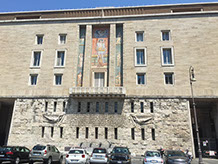 At the Piazza Augusto Imperiatore to see the Tomb of Augustus, admire the Mussolini architecture of the surrounding buildings and the giant mural celebrating fascism.
At the Piazza Augusto Imperiatore to see the Tomb of Augustus, admire the Mussolini architecture of the surrounding buildings and the giant mural celebrating fascism.
Mausoleum of Augustus was a place of prominence featured in Benito Mussolini's ambitious reordering of the city of Rome which strove to connect the aspirations of Italian Fascism with the former glories of the Roman Empire. Mussolini viewed himself especially connected to the achievements of Augustus, seeing himself as a 'reborn Augustus' ready to usher in a new age of Italian dominance.
 In Via di Santo Stefano del Cacco there is an enormous marble foot (“Piè di Marmo”) – the sandaled left foot of a huge statue of a female deity from the nearby temple dedicated to the Egyptian gods Isis and Serapis (the Iseo Campense). During the Middle Ages the marble foot lay at the junction between Via del Piè di Marmo and Piazza del Collegio Romano, and it was moved to its present position in 1878 on occasion of the funeral ceremony of King Victor Emanuel II.
In Via di Santo Stefano del Cacco there is an enormous marble foot (“Piè di Marmo”) – the sandaled left foot of a huge statue of a female deity from the nearby temple dedicated to the Egyptian gods Isis and Serapis (the Iseo Campense). During the Middle Ages the marble foot lay at the junction between Via del Piè di Marmo and Piazza del Collegio Romano, and it was moved to its present position in 1878 on occasion of the funeral ceremony of King Victor Emanuel II.
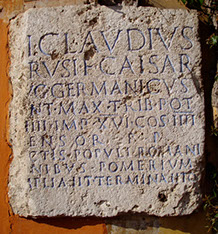 At the northwest end of Via del Pellegrino, set into the façade of an undistinguished building, is a block of stone inscribed with the following text:
At the northwest end of Via del Pellegrino, set into the façade of an undistinguished building, is a block of stone inscribed with the following text:
[t]I CLAVDIVS
[d]RVSI FILIVS CAISAR
[a]VG GERMANICVS
[po]NT MAX TRIB POT
[v]IIII IMP XVI COS IIII
CENSOR P P
[au]CTIS POPVLI ROMANI
[fi]NIBVS POMERIVM
[a]MPLIAℲIT TERMINAℲITQ
"Tiberius Claudius Caesar Augustus Germanicus, son of Drusus, Supreme Pontiff, vested with the Tribunician power for the ninth time, Consul for the fourth, Censor, Father of his Country, upon the enlargement of the territory of the Roman people increased and delimited the pomerium."
The inscription declares the Emperor Claudius’ extension of the pomerium – Rome’s sacred boundary. In antiquity, the pomerium formed the religious limit of a city that had been augurally constituted – that is, one whose territory had been ‘inaugurated’ by the public diviners (augures) who interpreted the will of the gods. In that ritual, a bullock and a heifer were yoked to a plow, and a furrow was drawn around the site of the new town. The pomerium was identified with the ridge of earth raised by the plow-share on the inner side of the furrow.
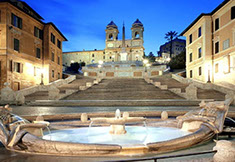 The Spanish Steps are not Spanish
The Spanish Steps are not Spanish
Is nothing sacred? Say it isn’t so. Sorry – if we are being truthful, the Spanish Steps are mainly French, in that they were funded by a donation from a French diplomat, Etienne Gueffier. There is also a case for them being Italian, as they were crafted by two Italian architects, Francesco de Sanctis and Alessandro Specchi – although, seeing as the Kingdom of Italy did not come into being until 1861, and the staircase was built between 1723 and 1725, that description is also problematic.
But Spanish? No. The name comes from the fact that the Spanish Embassy was, at the time of their construction, located at the base of the stairs. However, in 1723, Spain had a Bourbon-French king, Philip V – who was so French that he was a grandson of Louis XIV, and had been born in Versailles. Still, “The French Steps That Are Also A Bit Italian, Only Not” doesn’t have a ring to it.
 Mussolini under your feet.
Mussolini under your feet.
Glance downward occasionally and you might still see the 'Fascia' symbol of Mussolini's Italy on a manhole cover. The bundle of reeds tied with an axe still pops up in surprising places.
There are several covers on the Via del Quirinale and the Corso de Rinascemento.
 "Ugly Piazza Rotondo" plaque
"Ugly Piazza Rotondo" plaque
In 1823, Pope Pius VII, tired of the mess the square outside the Pantheon had become, had a large marble plaque erected on the wall opposite, still visible, which reads:
"Pius Maximus, pontifex maximus, in the twenty third year of his pontificate, on the square in front of M. Agrippa's Pantheon, occupied by vile taverns, justifies their providential demolition on account of their loathsome ugliness, and orders that the view be left unhindered."
... back to top of page
